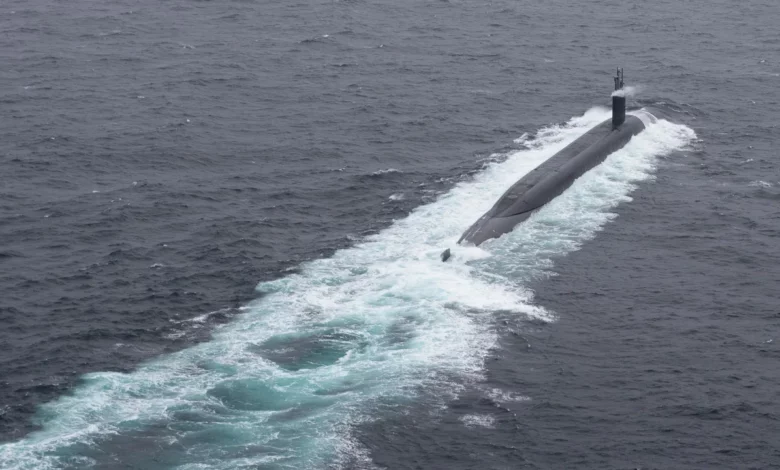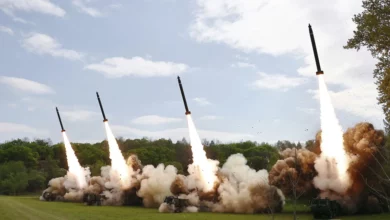
For the first time in decades, a nuclear capable US Navy ballistic missile submarine has made a port call in South Korea, in a move that comes just days after North Korea test-fired what it said was a solid-fueled intercontinental ballistic missile.
The presence of the Ohio-class ballistic missile submarine in the South Korean port city of Busan was announced by the country’s Defense Ministry on Tuesday afternoon.
It came as Kurt Campbell, coordinator for the Indo-Pacific at the US National Security Council, was at the inaugural meeting in Seoul of the Nuclear Consultative Group (NCG).
The NCG is a joint US and South Korean panel set up by the countries’ leaders at a summit in Washington in April.
The arrival of the submarine follows a period of heightened tensions on the peninsula, during which North Korea has both tested what it said was an advanced long range missile and threatened to shoot down US military reconnaissance aircraft engaging in what it called “hostile espionage” activities near its territory.
Kim Yo Jong, sister of North Korean leader Kim Jong Un and a senior official in her own right, said in a statement Monday the deployment of a US ballistic missile submarine to the peninsula would damage already fractured lines of communication between the two sides.
“The reality before the DPRK (Democratic People’s Republic of Korea) is not dialogue repeatedly touted by the US,” said Kim. Instead, she said, the NCG was “openly discussing the use of nukes against the DPRK and the entry of US strategic nuclear submarine into waters of the Korean Peninsula for the first time in 40-odd years.”
“The US should know that its bolstered extended deterrence system and excessively extended military alliance system, a threatening entity, will only make the DPRK go farther away from the negotiating table desired by it,” the statement added.
Sub can carry up 80 warheads
Known colloquially as “boomers,” each of the Ohio-class subs can carry a maximum of 20 Trident II ballistic missiles.
The Nuclear Threat Initiative at the James Martin Center for Nonproliferation Studies estimates that each Trident missile can carry four nuclear warheads, meaning each US ballistic missile submarine could be carrying about 80 nuclear warheads.
The port call came out of an agreement between US President Joe Biden and South Korean President Yoon Suk Yeol when the met in the US capital in April. The “Washington Declaration” included a set of measures aimed at making Pyongyang think twice about launching an attack on its southern neighbor.
“Our mutual defense treaty is iron clad and that includes our commitment to extend a deterrence – and that includes the nuclear threat, the nuclear deterrent,” Biden said at the time.
The establishment of the NCG came out of that Biden-Yoon meeting.
In a joint statement on Tuesday the two allies said the NCG would enhance “combined deterrence and response posture.”
“As a result, the collective strength of our two nations will directly contribute to the continued peace and stability on the Korean Peninsula and across the Indo-Pacific region,” the statement read.
“This inaugural NCG meeting afforded the United States an opportunity to reaffirm and strengthen the US commitment to provide extended deterrence to the ROK backed by the full range of US capabilities, including nuclear,” it added.
Little military value
Analysts said after the “Washington Declaration” that the presence of a US Navy ballistic missile submarine in a South Korean port would be purely symbolic – and in fact would reduce the military value of the sub.
“Tactically, (the US and South Korea) are diminishing the sub’s most powerful asset; its stealthiness,” Carl Schuster, former director of operations at the US Pacific Command’s Joint Intelligence Center in Hawaii, said in April.
The Trident missiles have a range of 4,600 miles (7,400 kilometers), meaning they are capable of hitting a target in North Korea from vast swathes of the Pacific, Indian or Arctic oceans.
“Militarily, (these submarines) don’t need to be anywhere near Korea in order to reach potential targets there,” Blake Herzinger, a research fellow at the United States Studies Centre, said in April.
One of the keys to nuclear deterrence is uncertainty.
A US ballistic missile sub lurking hundreds of feet below the ocean’s surface thousands of miles from North Korea would still be within striking range of Pyongyang, but would be near impossible for North Korea to spot.
One arriving in South Korea on a port visit – which must be arranged 24 to 48 hours in advance – would be far more visible, giving North Korea an advantage, Schuster said.
“If Kim Jong Un was looking to do a surprise strike, we’ve given him the submarine’s location and time it will be there,” Schuster said.




